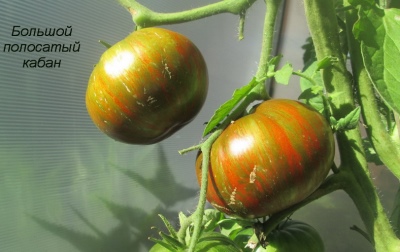
- Authors: Brad Gates (private company "Wild Boar", California, USA)
- Name synonyms: Large Barred Boar
- Category: grade
- Growth type: indeterminate
- Appointment: fresh consumption, for juice, for ketchup and tomato paste
- Ripening period: mid-season
- Growing conditions: for open ground, for greenhouses
- Bush size: tall
- Bush height, cm: 200
- Leaves: ordinary
Gradually, tomatoes of American selection turn out to be more and more powerful contenders for domestic and foreign varieties. Among them, an important place is occupied by the Great Striped Boar. And farmers will only benefit from a careful acquaintance with it.
Breeding history
Created the Big Striped Boar by Brad Gates. The main breeding works were carried out at the Wild Boar firm. To obtain the culture, special lands in the state of California were used. The plant has an official synonym - Large Barred Boar.
Description of the variety
The large striped boar is a prominent representative of indeterminate cultures. It can be planted both in open ground and in greenhouses. The bushes of this tomato are quite tall and reach 2 m. The leaves are of the "normal" type. Growing - regardless of greenhouse or open planting - should only be in sunny places.
The main qualities of the fruit
The variety justifies its name by the already dominant burgundy-brown color. This color is complemented by green stripes. The mass of the berries is 300-400 g. In shape, they are close to flat roundness. The fruits are also quite large, weighty.
Taste characteristics
The Big Striped Boar is sweet enough to taste. Yes, it also has a characteristic sour note. But it does not create an unpleasant sensation at all; moreover, it creates a comfortable ensemble of fruit flavors. The pulp of the fruit of the sugar. The pleasant aroma is also worth noting.
You can use the harvested crop as:
part of the salad;
vegetable or combined cutting;
canned pieces;
raw materials for pasta, sauce or juice.
Ripening and fruiting
The large striped boar is considered a mid-season tomato. After the beginning of the formation of ovaries, it will supply people with a crop for a long time. Sometimes the collection lasts until the onset of frost. You can wait for the harvest 100-109 days after germination. Only occasionally unpredictable meteorological conditions correct this regime.
Yield
The number of fruits will be quite large. 6-8 fruiting brushes develop on the bush. 6 kg of berries are obtained per plant per season. Collect on 1 sq. m harvest of 15 kg of tomatoes is likely. Under favorable conditions and a competent general approach, the collection increases even up to 18 kg.
The timing of planting seedlings and planting in the ground
Sowing in containers is carried out in the first or second decade of March. Seeds are pre-disinfected with potassium permanganate or calcined. Planting ready-made seedlings in open ground is carried out on days 55-60 of development. Additionally, hardening may be required. For him, seedlings are kept for about 7 days at a temperature of +14 degrees.

Growing tomato seedlings is an extremely important process, because it largely depends on whether the gardener will be able to harvest at all. All aspects must be taken into account, from seedbed preparation to planting in the ground.
Landing scheme
There is nothing surprising here.It is recommended to limit the placement of 3 bushes per 1 m2.

Growing and care
For this variety, both garter and shaping are required. When the bush is formed, 2 or 3 stems should be left. A number of sources indicate that greenhouse planting is preferable in the northern regions of the Russian Federation, and ordinary vegetable gardens can be used in the south. Water the plant regularly. Normally, 1 bush uses 4 liters of clean warm water.




A plant needs different micronutrients at each stage of growth. All fertilizers can be divided into two groups: mineral and organic. Folk remedies are often used: iodine, yeast, bird droppings, eggshells.
It is important to observe the rate and period of feeding. This also applies to folk remedies and organic fertilizers.
Disease and pest resistance
Viral infections for the Great Striped Boar do not pose any significant danger. But a fungal infection is much more likely. Late blight is also a threat. When infected, they should use Fundazol or Ordan. Pests specific to this variety have not been described.


Resistant to adverse weather conditions
Hot season Big striped wild boar is going through well. It is even quite resistant to dry, sultry periods. But it is unreasonable to abuse this property of the plant. Otherwise, the quantity and quality of the crop can discourage even the most demanding gardeners. Temperature surges do not pose a particular threat.
Review overview
According to gardeners, the Large Striped Boar grows well in the greenhouse. The wet rainy summer doesn't even bother him. The gastronomic characteristics of the crop are quite high.With careful care, gardeners will be fully rewarded. Tomatoes are not only delicious, but also very beautiful.

























































































